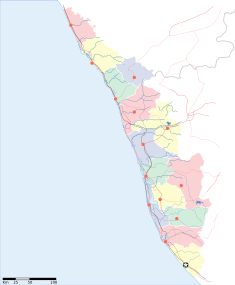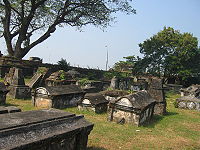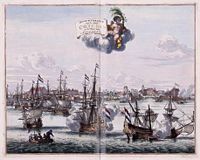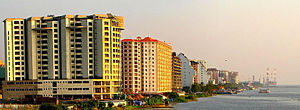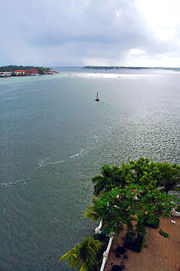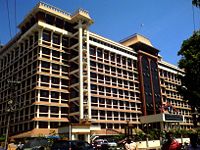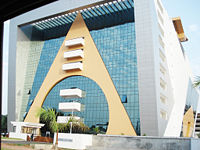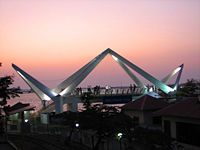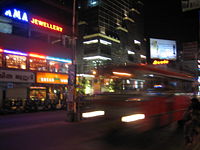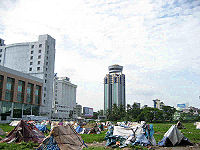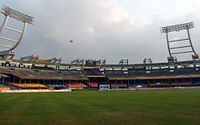Kochi, India
2008/9 Schools Wikipedia Selection. Related subjects: Geography of Asia
| ?Kochi Kerala • India |
|
| Nickname: Queen of the Arabian Sea | |
|
Image:Skyline de Kochi.jpg
|
|
|
|
|
| Coordinates: | |
| Time zone | IST ( UTC+5:30) |
| Area • Elevation • Coastline |
94.88 km² (37 sq mi) • 0 m (0 ft) • 48 km (30 mi) |
| Climate • Precipitation |
Am ( Köppen) • 2,743 mm (108 in) |
| District(s) | Ernakulam |
| Population • Density • Metro • Sex ratio • Literacy rate |
596,473 (2001) • 6,250 /km² (16,187 /sq mi) • 1,463,000 ( 2005) • 1.017 • 94.3% |
| Mayor | Mercy Williams |
| Deputy Mayor | C. K. Manisankar |
| Codes • Pincode • Telephone • UN/LOCODE • Vehicle |
• 682 0xx • +0484 • INKOC • KL-7 |
| Website: www.corporationofcochin.org | |
Coordinates: Kochi ( pronunciation ; Malayalam: കൊച്ചി IPA: [koˈʧːi]), formerly known as Cochin, is a city in the Indian state of Kerala. The city is one of the principal seaports of the country and is located in the district of Ernakulam, about 220 kilometres (137 mi) north of the state capital, Thiruvananthapuram. It has an estimated population of 600,000, with an extended metropolitan population of about 1.5 million, making it the largest urban agglomeration and the second largest city in Kerala after the capital.
Since 1102 CE, Kochi was the seat of the Kingdom of Cochin, a princely state which traces its lineage to the Kulasekhara empire. Heralded as the Queen of the Arabian Sea, Kochi was an important spice trading centre on the Arabian Sea coast from the 14th century onwards. Ancient travellers and tradesmen referred to Kochi in their writings, variously alluding to it as Cocym, Cochym, Cochin, and Cochi. Occupied by the Portuguese in 1503, Kochi was the site of the first European colonial settlement in India. It remained the capital of Portuguese India until 1530, when Goa became the capital. The city was later occupied by the Dutch, the Mysore and the British. Kochi was the first princely state to willingly join the Indian Union, when India gained independence in 1947.
Kochi experienced decades of economic stagnation from independence until 2003, when it entered a period of economic growth, leading to a spurt in the city's development. A growing centre of information technology, tourism and international trade, Kochi is the commercial hub of Kerala, and one of the fastest growing second-tier metros in India. Like other large cities in the developing world, Kochi continues to struggle with urbanisation problems such as traffic congestion and environmental degradation.
Successive waves of migration over the course of several millennia have made Kochi a cultural melting pot. Despite the risk of overdevelopment, the city retains its distinct colonial heritage and a blend of tradition and modernity.
Name
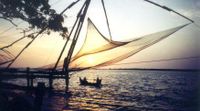
Theories regarding the etymology of the name "Kochi" are disputed. One suggests that the city's modern name is derived from the Malayalam word koch azhi, meaning 'small lagoon'. Another version mentions the name as derivative of the Sanskrit word Go shree which means 'prosperous with cows'. Certain ancient texts refer to the city Balapuri (Sanskrit for 'small town'), which became Cochin in course of time. According to some accounts, traders from the court of the Chinese ruler Khubilai Khan gave Cochin the name of their homeland. Yet another theory is that Kochi is derived from the word Kaci meaning 'harbour'. Certain scholars claim that Cochin is derived from the term Cocha, which is a transfiguration of the Biblical term Cohen. Accounts by Italian explorers Nicolo Conti (15th century), and Fra Paoline in the 17th century say that it was called Kochchi, named after the river connecting the backwaters to the sea.
After the arrival of the Portuguese, and later the British, the name Cochin stuck as the official appellation. The city reverted to a closer anglicisation of its original Malayalam name, Kochi, in 1996. However, it is still widely referred to as Cochin.
History
Kochi was the centre of Indian spice trade for many centuries, and was known to the Yavanas (Greeks) as well as Romans, Jews, Arabs, and Chinese since ancient times. Kochi rose to significance as a trading centre after the port at Kodungallur (Cranganore) was destroyed by massive flooding of the river Periyar in 1341. The earliest documented references to Kochi occur in books written by Chinese voyager Ma Huan during his visit to Kochi in the 15th century as part of Admiral Zheng He's treasure fleet. There are also references to Kochi in accounts written by Italian traveller Niccolò Da Conti, who visited Kochi in 1440.
The Kingdom of Kochi came into existence in 1102, after the fall of the Kulasekhara empire. The King of Kochi had authority over the region encompassing the present city of Kochi and adjoining areas. The reign was hereditary, and the family that ruled over Kochi was known as the Cochin Royal Family (Perumpadappu Swaroopam in the local vernacular). The mainland Kochi remained the capital of the princely state since the 18th century. However, during much of this time, the kingdom was under foreign rule, and the King often only had titular privileges.
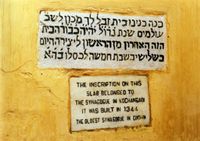
Fort Kochi in Kochi was the first European colonial settlement in India. From 1503 to 1663, Fort Kochi was ruled by Portugal. This Portuguese period was difficult for the Jews installed in the region, since the Inquisition was active in Portuguese India. Kochi hosted the grave of Vasco da Gama, the first European explorer to set sail for India, who was buried at St. Francis Church until his remains were returned to Portugal in 1539. The Portuguese rule was followed by that of the Dutch, who had allied with the Zamorins in order to conquer Kochi. By 1773, the Mysore King Hyder Ali extended his conquest in the Malabar region to Kochi forcing it to become a tributary of Mysore. The hereditary Prime Ministership of Kochi held by the Paliath Achans came to an end during this period.
Meanwhile, the Dutch, fearing an outbreak of war on the United Provinces signed a treaty with the United Kingdom, under which Kochi was ceded to the United Kingdom in exchange for the island of Bangka. However, there are evidences of English habitation in the region even prior to the signing of the treaty. In 1866, Fort Kochi became a municipality, and its first Municipal Council election was conducted in 1883. The Maharaja of Cochin, who ruled under the British, in 1896 initiated local administration by forming town councils in Mattancherry and Ernakulam. In 1925, Kochi legislative assembly was constituted due to public pressure on the state.
Towards the early 20th century, trade at the port had increased substantially, and the need to develop the port was greatly felt. Harbour engineer Robert Bristow was brought to Kochi in 1920 under the direction of Lord Willingdon, then the Governor of Madras. In a span of 21 years, he transformed Kochi as one of the safest harbours in the peninsula, where ships berthed alongside the newly reclaimed inner harbour equipped with a long array of steam cranes.
In 1947, India gained independence from the British colonial rule. Cochin was the first princely state to join the Indian Union willingly. In 1949, Travancore-Cochin state came into being with the merger of Cochin and Travancore. The King of Travancore was the Rajpramukh of the Travancore-Cochin Union from 1949 to 1956. Travancore-Cochin, was in turn merged with the Malabar district of the Madras State. Finally, the Government of India's States Reorganisation Act (1956) inaugurated a new state — Kerala — incorporating Travancore-Cochin (excluding the four southern Taluks which were merged with Tamil Nadu), Malabar District, and the taluk of Kasargod, South Kanara. On 9 July 1960, the Mattancherry council passed a resolution—which was forwarded to the government—requesting the formation of a municipal corporation by combining the existing municipalities of Fort Kochi, Mattancherry, and Ernakulam. The government appointed a commission to study the feasibility of the suggested merger. Based on its report, the Kerala Legislative Assembly approved the corporation's formation. On 1 November 1967, exactly eleven years since the establishment of the state of Kerala, the corporation of Cochin came into existence. The merger leading to the establishment of the corporation, was between the municipalities of Ernakulam, Mattancherry and Fort Kochi, along with that of the Willingdon Island, four panchayats ( Palluruthy, Vennala, Vyttila and Edappally), and the small islands of Gundu and Ramanthuruth.
Kochi witnessed economic stagnation in the years following India's independence. The city's economic recovery gathered momentum after economic reforms in India introduced by the central government in the mid-1990s. Since 2000, the service sector has revitalised the city’s stagnant economy. The establishment of several industrial parks based on Information technology (IT) and other port based infrastructure triggered a construction and realty boom in the city. Over the years, Kochi has witnessed rapid commercialisation, and has today grown into the commercial capital of Kerala.
Geography and climate
Kochi is located on the southwest coast of India at , spanning an area of 94.88 square kilometres (36.63 sq mi). The city is situated at the northern end of a peninsula, about 19 kilometres (12 mi) long and less than one mile (1.6 km) wide. To the west lies the Arabian Sea, and to the east are estuaries drained by perennial rivers originating in the Western Ghats. Much of Kochi lies at sea level, with a coastline of 48 km.
The current metropolitan limits of Kochi include the mainland Ernakulam, old Kochi, the suburbs of Edapally, Kalamassery and Kakkanad to the northeast; Tripunithura to the south east; and a group of islands closely scattered in the Vembanad Lake. Most of these islands are very small, varying in extent from six square kilometre to less than a square kilometre (1,500 to less than 250 acres).
Soil consists of sediments such as alluvium, teri's, brown sands etc. Hydromorphic saline soils are also found in the areas surrounding the backwaters. Predominant rock types found here are Archaean-basic dykes, Charnockites and Gneisses. An ecologically sensitive area, the Mangalavanam Bird Sanctuary is located in the central part of the city. It has a wide range of mangrove species and is nesting ground for a vast variety of migratory birds. Certain species of dolphins are also present in the backwaters.
Kochi's proximity to the equator along with its coastal location results in little seasonal temperature variation, with moderate to high levels of humidity. Annual temperatures range between 20 to 35 ° C (68–95 ° F) with the record high being 34 °C (96 °F), and record low 17 °C (63 °F). From June through September, the south-west monsoon brings in heavy rains as Kochi lies on the windward side of the Western Ghats. From October to December, Kochi receives light rain from the northwest monsoon, as it lies on the leeward side. Average annual rainfall is 274cms (108 in), with an annual average of 132 rainy days.
Civic administration
|
The city is administered by the Kochi Corporation, headed by a mayor. For administrative purposes, the city is divided into 70 wards, from which the members of the corporation council are elected for a period of five years. Earlier; Fort Cochin, Mattancherry and Ernakulam were the three Municipalities in Cochin area, which was later merged to form the Cochin Corporation. The Corporation has its headquarters in Ernakulam, and zonal offices at Fort Kochi, Mattancherry, Palluruthy, Edappally, Vaduthala and Vyttila. The general administration of the city is handled by the Personnel Department and the Council Section. Other departments include that of town planning, health, engineering, revenue and accounts. The corporation is also responsible for waste disposal, sewage management and the supply of potable water, sourced from the Periyar River. Electricity is provided by the Kerala State Electricity Board.
The Greater Cochin Development Authority (GCDA) is the government agency overseeing the development of Kochi. The Kochi City Police is headed by a Police Commissioner, an Indian Police Service (IPS) officer. It comprises the traffic police, Narcotics Cell, Armed Reserve Camps, District Crime Records Bureau, Senior citizen's Cell, and a Women's Cell. It operates 19 police stations functioning under the Home Ministry of State Government. An anti-corruption branch of the Central Bureau of Investigation also operates out of the city. Kochi is the seat of the High Court of Kerala, the highest judicial body in the state.
Kochi contributes five seats to the State Assembly, and a seat to the Lok Sabha, the Lower House of the Indian Parliament.
Economy
Kochi is the economic capital of Kerala by volume of trade; though, unlike other South Indian cities, Kochi has been slow to industrialise. In recent years the city has rejuvenated from its economic stagnation and has witnessed heavy investment, thus making it one of the fastest-growing second-tier metro cities in India. The economy of the city can be classified as a business economy with emphasis on the service sector. Major business sectors include gold and textile retailing, seafood and spices exports, information technology (IT), tourism, health services, banking, shipbuilding, and the fishing industry. The economy is mostly dependent on trade and retail activities. As in most of Kerala, remittances from non-resident Indians (NRI)s is a major source of income. The city also houses Kerala's only bourse—the Cochin Stock Exchange.
Kochi is a major destination for IT and ITES companies, ranked by NASSCOM as the second-most attractive city in India for IT-based services. Availability of cheap bandwidth through undersea cables and lower operational costs compared to other major cities in India, has been to its advantage. Various technology and industrial campuses including the government promoted InfoPark, Cochin Special Economic Zone and KINFRA Export Promotion Industrial Park operate in the outskirts of the city. Several new industrial campuses for research, trade and development in biotechnology, electronic hardware and information technology are in various stages of construction in the suburbs of the city. Prominent among them are the Sobha Hi-tech city at Maradu and the SmartCity at Kakkanad, which on completion, would rank among the largest such ventures in the country. The Cochin International Airport is also in the process of setting up an aerotropolis at Nedumbasserry.
Eloor, situated 17 kilometres (10.5 mi) north of the city, is the largest industrial belt in Kerala, with more than 250 industries manufacturing a range of products including chemical and petrochemical products, pesticides, rare earth elements, rubber processing chemicals, fertilisers, zinc and chromium compounds, and leather products.
Kochi is the headquarters of the Southern Naval Command, the primary training centre of the Indian Navy. The Cochin Shipyard in Kochi is the largest shipbuilding facility in India. The Cochin fishing harbour, located at Thoppumpady is a major fishing port in the state and supplies fish to local and export markets. To further tap the potential of the all-season deep-water harbour at Kochi, an international cruise terminal and several marinas are being constructed.
Exports and allied activities are also important contributors to the city's economy. The Cochin Port currently handles export and import of container cargo at its terminal at Willington Island. A new international container transshipment terminal—the first in the country—is being commissioned at Vallarpadam. Kochi's historical reliance on trade continues into modern times, as the city is a major exporter of spices and is home to the International Pepper Exchange, where black pepper is globally traded. The Spices Board of India is also headquartered in Kochi.
Kochi also has an oil refinery—the Kochi Refineries (BPCL) at Ambalamugal. Central Government establishments like the Coconut Development Board, the Coir Board and the Marine Products Export Development Authority (MPEDA) have head offices located in the city.
Transport
Public transport in the city is largely dependent on private buses. Taxis and autorickshaws (called autos) are available for hire throughout the day. Narrow roads and the mix of vastly differing types of vehicles have made traffic congestion a problem in the city. A metro rapid transit service, intended to considerably ease congestion, is currently under construction.
Because it is one of the safest harbours in the Indian Ocean, Kochi ranks among India's major seaports. The port, administered by a statutory autonomous body known as the Cochin Port Trust, offers facilities for bunkering, handling cargo and passenger ships and storage accommodation. It also operates passenger ships to Colombo and Lakshadweep. Boat services operated by Kerala Shipping and Inland Navigation Corporation, the State Water Transport Department, and of private ownership are available from various boat jetties in the city. The junkar ferry for the transshipment of vehicles and passengers between the islands are operated between Ernakulam and Vypin, and between Vypin and Fort Kochi. However, with the construction of the Goshree bridges (which links Kochi's islands), ferry transport has become less essential.
The Cochin International Airport, which is about 25 kilometres (15 mi) north of the city, handles both domestic and international flights. It is the largest airport of Kerala, and one of the busiest in India. It is the first international airport in India to be built without Central Government funds. An airport run by the Navy also operates in the city. A third airport, for use by the Indian Coast Guard, is under construction in the suburbs.
There is no intra-city rail transport system in Kochi. The inter-city rail transport system in the city is administered by the Southern Railway division of the Indian Railways. There are two main railway stations—the Ernakulam Junction and the Ernakulam Town (locally known as the 'South' and 'North' railway stations respectively). The railway line connecting these two stations cuts the city longitudinally in two, with two narrow bridges connecting the two halves.
Demographics
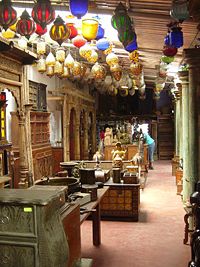
As of 2001, Kochi had a population of 596,473, with a density of 6850.7 persons per square kilometre. Scheduled castes and tribes comprise 14.3% of the city's population. The female-to-male ratio is 1,024:1,000, significantly higher than the all-India average of 933:1,000. Kochi's literacy rate is 94.3%. The female literacy rate lags that of males by 1.1%, amongst the lowest such gaps in India.
Kochi's major religions are Hinduism, Christianity, and Islam; Jainism, Judaism, Sikhism, and Buddhism have smaller followings. Though 47% practise Hinduism, Christianity's large following (35%) makes Kochi a city with one of the largest Christian populations in India. The majority of residents are Malayalis; however, there are significant ethnic minority communities including Tamils, Gujaratis, Jews, Sikkimese, Anglo-Indians, Konkanis, and Tulus. Malayalam is the main language of communication and medium of instruction, although English is more commonly used in business circles. Tamil and Hindi are widely understood—albeit rarely spoken.
Like other fast-growing cities in the developing world, Kochi suffers from major urbanisation problems, poor sanitation, and unemployment. However, a survey conducted in 2007 by a private agency considered Kochi to be the best city to live in India.
The city registered an increase of 9.7% in its unemployment rate from 14.8% in 1998 to 24.5% in 2003. Shortage of potable water is a major concern in the city. The situation is aggravated by the threat posed by pollution in industrial areas. The city also has a growing slum-dwelling population. The government has plans to make the city slum-free by 2016. Kochi has a high suicide rate with 32 suicides per lakh, which is three times higher than the national average of 11.2 per lakh. According to the National Crime Records Bureau, Kochi has one of highest rates of crime in India—498.6, against the national average of 287.3. However, a survey conducted by The Week, found Kochi to be the safest city in India for women.
Culture
As a result of successive waves of migration over the course of several centuries, the population of the city is a mix of people from all parts of Kerala and most of India. The pan-Indian nature is highlighted by the substantial presence of various ethnic communities from different parts of the country. Kochi has a diverse, multicultural, and secular community consisting of Hindus, Christians, Muslims, Jains, Sikhs, and Buddhists among other denominations, all living in peaceful co-existence. The city once had a large Jewish community, known as the Malabar Yehuden—and now increasingly as Cochin Jews—that figured prominently in Kochi's business and economic strata. The Syro-Malabar Church, one of the 22 sui iuris Eastern Catholic Churches, has its seat at Ernakulam. Appropriate to its multi-ethnic composition, Kochi celebrates traditional Kerala festivals like Onam and Vishu along with North Indian Hindu festivals like Holi and Diwali with great fervour. Christian and Islamic festivals like Christmas, Easter, Eid ul-Fitr and Milad-e-sherif are also celebrated. A merry making fest called the Cochin Carnival is celebrated at Fort Kochi during the last ten days of December.
Residents of Kochi are known as Kochiites; they are an important part of the South Indian weltanschauung. However, the city's culture is rapidly evolving, with Kochiites generally becoming more cosmopolitan in their outlook. The people are also increasingly fashion-conscious, often deviating from the traditional Kerala wear to western clothing.
Kochiites generally partake of Keralite cuisine, which is generally characterised by an abundance of coconut and spices. Other South Indian cuisines, as well as Chinese and North Indian cuisines are popular. Fast food culture is also very prominent.
Kochi was home to some of the most influential figures in Malayalam literature, including Changampuzha Krishna Pillai, Kesari Balakrishna Pillai, G. Sankara Kurup, and Vyloppilli Sreedhara Menon. Prominent social reformers such as Sahodaran Ayyappan and Pandit Karuppan also are from Kochi.
The Maharajas of Kochi (then Cochin) were scholars who knew the epics and encouraged the arts. The paintings at the Hill Palace and the Dutch Palace are testimony to their love.
Kochiites are known for their enthusiasm in sports, especially cricket and football. The Jawaharlal Nehru International Stadium in Kochi is one of the largest multi-use stadiums in India with International Class Lighting for Day and Night Matches. The Regional Sports Centre is an important centre of sporting activity in the city.
Education
Schools and colleges in the city are either run by the government or by private trusts and individuals. The schools are each affiliated with either the Indian Certificate of Secondary Education (ICSE), the Central Board for Secondary Education (CBSE), or the Kerala State Education Board. English is the medium of instruction in most private schools; though government run schools offer both English and Malayalam. After completing their secondary education, which involves ten years of schooling, students typically enrol at Higher Secondary School in one of the three streams— Arts, Commerce or Science. Upon completing the required coursework, the student can enroll in general or professional degree programmes.
The Cochin University is situated in the city. Most of the colleges offering tertiary education are affiliated either with the Mahatma Gandhi University or the Cochin University. Other national educational institutes include the Central Institute of Fisheries Nautical and Engineering Training, the National University of Advanced Legal Studies, the National Institute of Oceanography, the Central Marine Fisheries Research Institute and the Amrita Vishwa Vidyapeetham.
